Palliative care and COVID-19 in the Australian context: a review of patients with COVID-19 referred to palliative care
Ruwani Mendis A B F , Anita Haines A , Loretta Williams A , Kirsten Mitchener A , Fiona Grimaldi A , Marianne Phillips A , Margaret Shaw A C , Thy Pham Hoai Nguyen A D , Adrian Dabscheck A , Odette Spruijt A E and Maria Coperchini AA Western Health, 176 Furlong Road, St Albans, Melbourne, Vic. 3021, Australia.
B Department of Medicine, Western Health, The University of Melbourne, 176 Furlong Road, St. Albans, Vic. 3021, Australia.
C Mercy Palliative Care, 3 Devonshire Road, Sunshine, Vic. 3020, Australia.
D School of BioSciences, The University of Melbourne, Melbourne, Vic., Australia.
E Faculty of Medicine, Dentistry and Health, The University of Melbourne, Melbourne, Vic., Australia.
F Corresponding author. Email: ruwani.mendis@wh.org.au
Australian Health Review 45(6) 667-674 https://doi.org/10.1071/AH21157
Submitted: 3 May 2021 Accepted: 7 June 2021 Published: 27 August 2021
Journal Compilation © AHHA 2021 Open Access CC BY
Abstract
Objective Palliative care has played a key role in the response to the coronavirus disease 2019 (COVID-19) pandemic in Australia. This review of consecutive patients with COVID-19 referred to the palliative care consultancy service of a tertiary health service in Melbourne describes the palliative care experience with COVID-19 in Australia.
Methods The experiences of 55 patients (median age 86 years; interquartile range (IQR) 81–90 years; 55% male; median Charlson comorbidity score 6 (IQR 5–8); 85% with Australia-modified Karnofsky Performance Status ≤50; 67% from residential aged care facilities) were reviewed to collect relevant data points.
Results Most patients were referred for end-of-life care with symptoms including dyspnoea (80%) and agitation/delirium (60%). Continuous subcutaneous infusions were commenced in 71% of patients, with the most frequent medications being opioids and benzodiazepines in relatively small doses; 81% required ≤20 mg subcutaneous morphine equivalent and 64% required ≤10 mg subcutaneous midazolam over 24 h. Fifty patients (91%) died in hospital and the median time from palliative care referral to death was 3 days (IQR 1–5 days). Five patients were discharged back to residential aged care facilities. Overall, 80% of referrals were from the aged care team.
Conclusion Our patients had similar demographics, symptoms, medication needs and outcomes to patients in similar settings overseas. We found the symptom management of patients with COVID-19 to be generally straightforward. However, the psychosocial needs of patients were predominant and contributed to complexity. This study highlights the need for well-integrated relationships between the palliative care consultancy service and the diverse range of key treating teams involved in the delivery of pandemic health care.
What is known about the topic? Palliative care has played a key role in the response to the COVID-19 pandemic in Australia. There is limited research describing the Australian palliative care experience with the COVID-19 pandemic.
What does this paper add? Patients with COVID-19 referred to a hospital-based palliative care consultancy service in Australia had similar demographic characteristics, symptoms, medication needs and outcomes to patients with COVID-19 referred to other palliative care services in the UK and the US. There were significant psychosocial issues affecting patients, families and staff in the context of the pandemic.
What are the implications for practitioners? This study highlights the need for well-functioning working relationships between the palliative care consultancy service and other hospital teams that can be leveraged at a time of crisis, such as a pandemic, to provide optimal palliative care to patients.
Keywords: COVID-19, Australia, palliative care services, end-of-life, health systems, psychosocial support, pandemic, health funding and financing.
Introduction
The coronavirus disease 2019 (COVID-19) pandemic has challenged healthcare systems in both well-resourced and poorly resourced nations, and has highlighted the importance of strong public health systems.
In Australia, the State of Victoria experienced the highest number of COVID-19 infections, with 9358 cases between January and November 2020 and 820 deaths.1,2 Many of these COVID-19 cases were located in the western suburbs of Melbourne and within the catchment area of Western Health (WH).
Palliative care has played a key role in the COVID-19 response in Australia through the provision of symptom management guidance, psychosocial support for patients and families and care at the end of life. Although there are published data describing COVID-19 from the palliative care perspective,3–7 to the best of our knowledge there is little published literature describing the Australian palliative care experience with the COVID-19 pandemic.
This review aims to describe and document the profile, symptom burden, response to treatment and outcomes of patients with COVID-19 referred to the palliative care consultancy service of a major metropolitan health service in Melbourne, Victoria. It is anticipated that the results of this review will inform future palliative care clinical guidelines for patients with this diagnosis and provide a comparison with the international experience.
Methods
Design and setting
This is a retrospective review of consecutive patients with COVID-19 referred to the Palliative Care Consultancy Service at WH from 1 April to 30 September 2020. As the impact of the pandemic expanded to involve a greater geographical area, the first patient with COVID-19 was referred to WH in the west of Melbourne in April 2020, with no further patients referred after September 2020. A list of all COVID-19-positive patients referred during the stated time period was maintained in real time by a palliative care clinical nurse consultant (KM). In all, 55 patients were referred to the service across the two campuses of WH (Footscray Hospital and Sunshine Hospital). The referral to the palliative care consultancy for palliative care input was made by the patient’s primary treating team in keeping with the patient’s goals of care.
Ethics approval
Ethics approval for the study was obtained from the Low Risk Ethics Committee of WH (QA2020.100_70710). Study data were collected and managed using REDCap tools hosted at WH. REDCap (Research Electronic Data Capture) is a secure, web-based application designed to support data capture for research studies.8
Data collection
The electronic medical records of 55 patients with COVID-19 were reviewed by six palliative care clinical nurse consultants (CNCs; AH, KM, LW, MW, MP, FG) and two consultant palliative care physicians (RM, MC). Data were extracted from medical, nursing and allied health notes and hospital medication charts. Data included patient demographics, Charlson comorbidity index (CCI),9 the date and location of confirmation of COVID-19 and Australia-modified Karnofsky Performance Status (AKPS).10 Information around the referral included referral unit, palliative care phase (stable, unstable, deteriorating or terminal) at the time of referral,11 the reason for referral, symptom profile and patient outcome. Information regarding the number and nature of contacts made by the palliative care consult team was also collected. Information regarding symptom control medications used, as well as the doses and routes of administration, was collected from medication charts. Clinician assessment of complexity and effectiveness was determined retrospectively based on documentation by the consult team at follow-up.
Categorical variables are reported as percentages and continuous variables are reported as the median with interquartile range (IQR) as appropriate for the data distribution.
Results
From 1 April to 30 September 2020, 394 patients were admitted to WH with a diagnosis of COVID-19. Of those 394 patients, 55 were referred to the Palliative Care Consultancy Service at WH and 65 died (Fig. 1).
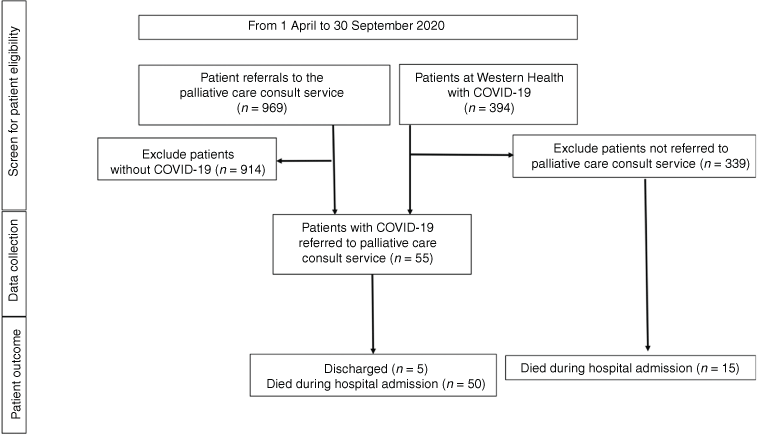
|
Patient demographics and details of the COVID-19 diagnoses are summarised in Table 1. Referred The median age of patients referred to the Palliative Care Consultancy Service was 86 years (IQR 81–90 years) and 55% were male. Most patients (67%) were admitted to hospital from residential aged care facilities. The AKPS was ≤50 in 85% of patients, and the median CCI score was 6 (IQR 5–8). The most common morbidities on the CCI were dementia (64%), followed by diabetes (47%).
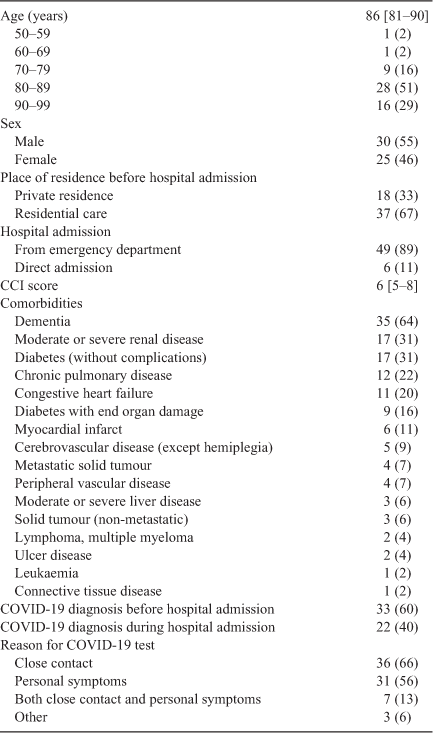
|
Patients were more likely to be diagnosed with COVID-19 before their hospital admission (60%) than in hospital (40%). Most patients were tested following close contact with a proven case (66%), but 44% were tested due to personal symptoms, the most common of which were shortness of breath, fever and cough (61.3%, 35.5% and 35.5% respectively).
Referral details and patient outcomes are summarised in Table 2. Most patients (80%) were referred by the Aged Care Team, with no referrals directly received from the Intensive Care or Emergency departments. Most patients (83%) were referred in either the deteriorating or terminal palliative care phase, and the purpose of the referral in 69% of referrals was end-of-life care.
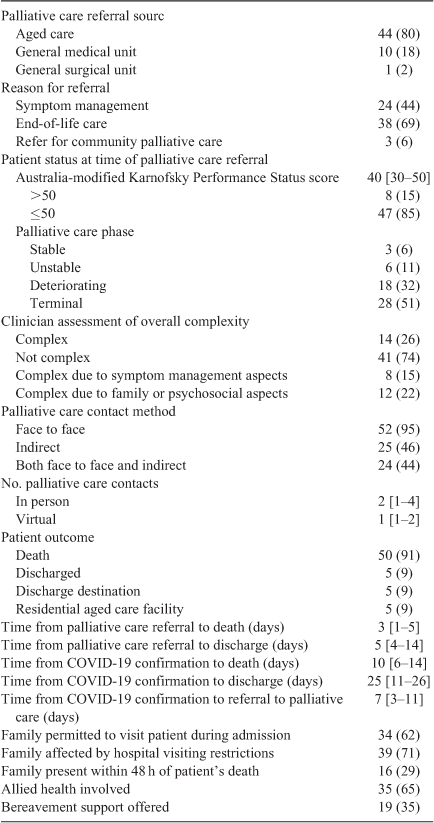
|
Contacts, either face to face or indirect, with a member of the Palliative Care Consultancy Service were few. Indirect contacts included contact with the treating team, family, allied health or community palliative care. The palliative care CNCs were instrumental in the majority of patient contacts (74%) and a member of the team made contact with the patient’s family in 19% of cases.
The most common symptoms requiring palliation were shortness of breath (80%) and agitation/delirium (60%; Fig. 2). Opioids were the most widely used medication for symptom management (Table 3). A continuous subcutaneous infusion (CSCI) of medication for symptom control was required in 71% of patients, and was commenced either at the time of referral or the day after. The most common medications used in the CSCI were midazolam (82%), morphine (62%) and hydromorphone (39%). Most patients (81%) required the ≤20 mg subcutaneous morphine equivalent over 24 h for optimal symptom control, with 46% requiring ≤10 mg over 24 h (oral morphine:subcutaneous morphine, 3:1; hydromorphone:morphine, 1:5). Subcutaneous midazolam at a dose of ≤10 mg over 24 h was sufficient for symptom control in 64% of patients, with 6% not requiring any midazolam at all.
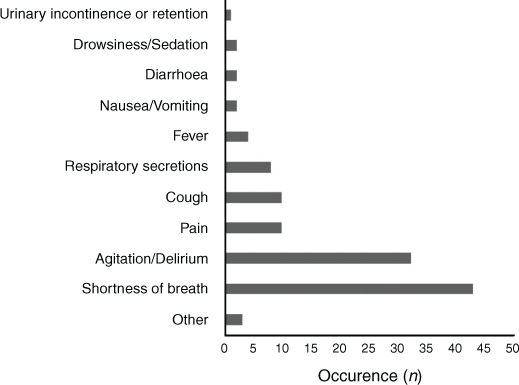
|
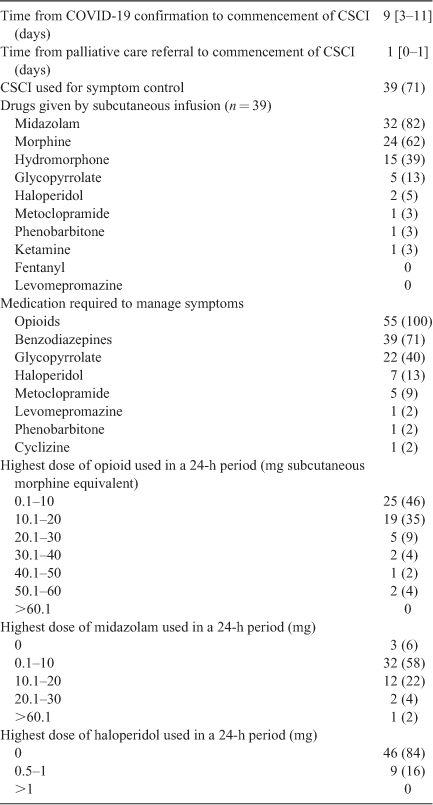
|
Most patients (91%) died in hospital, with the remaining five patients discharged back to their homes in residential aged care. No patients were escalated to intensive care. Case notes documented the presence of family members within 48 h of death for 32% of patients. In most cases (71%), families were negatively affected by hospital visitor restrictions in the setting of COVID-19. Bereavement support was initiated by the members of the Palliative Care Consultancy Service for 34% of patients.
The median time between referral to the Palliative Care Consultancy Service to death and discharge was 3 (IQR 1–5) and 5 (IQR 4–14) days respectively. The median length of time from the date of COVID-19 confirmation to referral to the Palliative Care Consultancy Service was 7 days (IQR 3–11 days).
In order to assess the level of need for specialist palliative care, we incorporated a subjective assessment by the reviewers, based on the documented severity of symptoms, level of symptom control and psychosocial aspects of each case. Seventy-five per cent of patients had uncomplicated palliative care needs and 26% were assessed to be complex. Of the patients who had complex palliative care needs, psychosocial issues were the cause for the complexity in 85% of cases.
Discussion
This report describes the demographics, symptom management and outcomes of patients with COVID-19 who were referred to a palliative care consultancy service of a metropolitan health service in Australia.
Our results are in keeping with those reported in the international literature.3,4,6,12 Patients with COVID-19 tend to be older, with a male preponderance, have a significant level of functional impairment and a high burden of comorbidities. Patients referred to palliative care were most commonly in the terminal phase of illness, and the purpose of the referral was to request assistance with end-of-life care. The duration of palliative care involvement tends to be brief for those patients who die.3,7,12 Given the rapid disease course in this patient group, early identification of the deteriorating patient with COVID-19 is required in order to prioritise optimum palliative care, symptom management and support at the end of life.
The most common symptoms in our cohort of patients were dyspnoea and delirium/agitation. CSCI was required in most cases, but with relatively low doses of opioids and benzodiazepines for effective symptom control, which is again in keeping with published reports.3,7 One patient, however, required high doses of midazolam for the management of unstable epilepsy in the context of severe COVID-19 infection. Cough was present as a symptom in 18.5% of patients. This is higher than in other centres in the UK, which have reported cough in <10% of patients.3,7 The reason for this difference is unknown and may provide the basis for future research. Possible explanations may include differences in the strain of virus and underlying differences in comorbidities and demographics between countries.
Our experience supports the international recommendations for CSCIs to be commenced promptly at conservative initial doses when the terminal phase is diagnosed in a patient with COVID-19 and the doses to be titrated to effect.5,7,12–14
Similar to the experience in other countries,3,5,15 symptom management and end-of-life care of the patient with COVID-19 was not complex in most cases. However, psychosocial aspects of care were identified as the cause for complexity in the majority of patients (85%) who did have complex palliative care needs.
The pandemic has presented unique challenges for health services as efforts to limit the risk of infection to staff and patients are balanced against the need for communication and support for patients and their families. In our experience, restricted visiting times and the move from face-to-face to virtual interactions compounded the anxiety and distress of many. The steps that are traditionally used by clinical teams when making decisions, such as face-to-face discussions with family members and family meetings that enable multidisciplinary input and information sharing, were not possible or minimised during the pandemic. Important discussions addressing goals of care and escalation or de-escalation of treatment happened virtually, detracting from the human element and adding to the distress and complexity not only for patients and families, but also for staff. In routine care, discussions with families happen incrementally with repetition so that loved ones have time to understand and come to terms with the information presented. However, in the setting of the pandemic, limitations to face-to-face communication, as well as the rapid deterioration of patients with COVID-19, meant decisions were made in a single sitting, leaving patients, families and clinicians with little time to process information. Other obstacles to effective communication during the pandemic in our experience included impediments to building rapport due to the perceived barriers from wearing of personal protective equipment (PPE), such as masks and gowns, and social distancing and the generally heightened levels of stress and anxiety among all parties. Our experience is similar to that of others who have described the psychosocial impact of the COVID-19 pandemic,16 and the effects of wearing masks on interpersonal communication.17
In our experience, loneliness and anxiety in patients who were in isolation due to suspected or confirmed COVID-19 infection significantly impaired quality of life as patients deteriorated and died. This was worse in elderly patients who had concurrent dementia or cognitive impairment who coped poorly with unfamiliar environments and the wearing of PPE by staff who cared for them. Patients from aged care had friends or acquaintances in the care homes who had contracted or died of COVID-19, which was an added source of grief and anxiety for them. Family members who contemplated visiting their elderly relatives with COVID-19 in hospital were fearful of attending hospital due to risk of exposure, resulting in feelings of guilt and uncertainty. The palliative care CNCs were able to see patients and then update the family over the telephone about their loved one’s progress. We have also identified that improving the connection between the dying or very unwell patient and their family is a major challenge to be overcome when providing care for patients and families in the midst of a pandemic. This is in keeping with previous work by Mayland et al., who have highlighted the need to find innovative ways to promote connections and adapt rituals and mourning practices during a pandemic situation.18 The impact of the loss of family or caregiver presence on the bereavement of caregivers needs to be explored further.4,18 Our experience of the loneliness and the social isolation suffered by older adults during the COVID-19 pandemic reflects similar findings to other groups who have studied this issue.19,20
Healthcare staff have also been significantly affected by the loss of connection between patients and families,4 calling for careful and ongoing review of the ethical dimensions of the public health measures employed during the COVID-19 pandemic. From our experience, psychosocial issues affecting staff members included feelings of being overwhelmed, feelings of powerlessness due to the increased number of COVID-19-related deaths, fear of exposure of self to COVID-19, fear of carrying COVID-19 to their families and friends through work-related exposure, fear of exposing their work colleagues to COVID-19 and work pressures due to increased patient numbers or complicated logistics of undertaking routine care activities during the pandemic. At WH, the palliative care team doctors and nurses who were more comfortable dealing with death on a daily basis were able to offer support to colleagues by being available for them to debrief and by offering encouragement at a difficult time.
In the present study, the Palliative Care Consultancy Service contacted the families of 19% of patients and bereavement support was initiated for 34% of patients. There are possible reasons for a less-than-anticipated rate of contact with families (19%) and referral to bereavement support (34%) as reflected in this study. There was sharing and crossover of duties during the pandemic, with a minimum number of essential staff encouraged to attend patients with COVID-19 to prevent unnecessary exposure and impact to the workforce. Other allied health services, such as social work, pastoral care and nurses, were also contacting patients’ families and referring patients for bereavement support depending on who had the best relationship with families. It is very likely that the absolute proportion of families contacted and the proportion receiving referrals for bereavement support were greater than the 19% and 34%, which was the proportion accounted for by the Palliative Care Consultancy Service alone. These data are also limited by the retrospective nature of the study and the completeness of documentation in patient records. As in other countries, like the UK, where bereavement support was offered through the extension of existing bereavement services, The Australian Centre for Grief and Bereavement established an Aged Care COVID-19 Grief and Bereavement Service that offered free support for those affected by COVID-19 in the aged care sector.21,22
A significant number of patients with COVID-19 referred to the WH Palliative Care Consultancy Service were admitted from residential aged care facilities (67%), and 80% of the total number of referrals came from the Aged Care team. Many of these patients had their diagnosis of COVID-19 confirmed before admission. This reflects the nature of the COVID-19 pandemic in Victoria, where outbreaks occurred in many residential aged care facilities. At the height of the pandemic, the Aged Care Liaison Service at WH supported 28 of the 90 residential aged care facilities within its catchment area. The existing working relationship between the Palliative Care Consultancy Service and the Aged Care team was strengthened during the pandemic through shared clinical responsibilities, collaborative education sessions and mutual support.
Different services around the world mobilised resources that were available to them in different ways to deal with the pandemic. At WH, due to the presence of other dedicated COVID-19 wards, the in-patient palliative care ward was maintained as a non-COVID-19 ward. The Palliative Care Consultancy Service provided support to all areas of the health service, including the COVID-19 wards, and adhered strictly to the guidelines regarding the use of PPE. The Palliative Care Consultancy Service was split in to two teams to service the two campuses and, where possible, each team was again split into two to service the COVID-19 and non-COVID-19 wards. This was to both minimise cross-transmission and limit the impact on the team in case of exposure. Rapidly organised education sessions were delivered by palliative care consultants to junior medical staff via video conference, and guidelines for symptom management and end-of-life care for patients with COVID-19 were prepared, based on available literature, and published on the hospital intranet as a resource for staff. Face-to-face contacts with patients were offered when it was clinically necessary and indirect contacts were encouraged where possible as a means to safeguard team members from exposure and quarantine while also minimising transmission to other in-patients.
From 1 April to 30 September 2020, during the COVID-19 pandemic, there were 969 referrals to the Palliative Care Consultancy Service, compared with 729 in the same time period in 2019. This reflects a 33% increase in referrals. Interestingly, a centre in the UK did not report an increase in referrals in the setting of the pandemic compared with their case load at the same time in the previous year.7 Because the proportion of patients with COVID-19 was small (6%), the increase in our workload cannot be directly attributed to patients with COVID-19; it may be due to recognition within WH of the value of referral to palliative care or to other indirect impacts of the pandemic. Broader monitoring of the trends in referrals and workload is required to better inform management of resources when planning for future pandemics. Increasing palliative care coverage to a 7-day model can be considered in future pandemic planning to increase the availability of good palliative care to rapidly deteriorating patients.
Of the 65 patients who died from COVID-19 at WH during this 6-month period, 77% were referred to the Palliative Care Consultancy Service. All patients referred had been triaged before referral to palliative care, and a decision made against escalation to critical care. This study is from a single centre and our findings may not apply to patients with COVID-19 who were not referred to palliative care and died in hospital, other patients with COVID-19 or to patients in in-patient or community palliative care settings. A study looking at all the patients who died with COVID-19 with a view to comparing those who received palliative care input to those who did not will provide valuable information.
Conclusions
Our results generally mirror those reported in the international literature with small differences, such as a greater proportion of patients with cough as a symptom and the increased total number of referrals to the Palliative Care Consultancy Service during the pandemic compared with previous years. Patients with COVID-19 referred to the hospital-based WH Palliative Care Consultancy Service in Australia had similar demographic characteristics, symptoms, medication needs and outcomes to patients with COVID-19 referred to other palliative care services in the UK and the US. There were significant psychosocial issues affecting patients, families and staff in the context of the pandemic. This study highlights the need for well-functioning working relationships between the Palliative Care Consultancy Service and other hospital teams that can be leveraged at a time of crisis, such as a pandemic, to provide optimal palliative care to patients.
Data availability
The data used to generate the results in this paper are available from the relevant protected data bank at WH.
Competing interests
None of the authors have any competing interests or conflicts to declare.
Declaration of funding
This research did not receive any specific funding.
Acknowledgements
The authors acknowledge their clinical colleagues at WH who continue to provide dedicated care to patients during the pandemic and beyond.
References
[1] Department of Health and Human Services, Victoria State Government. Coronavirus update for Victoria – 30 November 2020 [media release]. Available at https://www.dhhs.vic.gov.au/coronavirus-update-victoria-30-november-2020[2] Butt C. Ten graphs that show the rise and fall of Victoria’s COVID-19 second wave. The Age, 27 October 2020. Available at https://www.theage.com.au/national/victoria/ten-graphs-that-show-the-rise-and-fall-of-victoria-s-covid-19-second-wave-20201027-p5694b.html
[3] Lovell N, Maddocks M, Etkind SN, Taylor K, Carey I, Vora V, et al Characteristics, symptom management, and outcomes of 101 patients with COVID-19 referred for hospital palliative care. J Pain Symptom Manage 2020; 60 e77–81.
| Characteristics, symptom management, and outcomes of 101 patients with COVID-19 referred for hospital palliative care.Crossref | GoogleScholarGoogle Scholar | 32325167PubMed |
[4] Heath L, Yates S, Carey M, Miller M. Palliative care during COVID-19: data and visits from loved ones. Am J Hosp Palliat Care 2020; 37 988–91.
| Palliative care during COVID-19: data and visits from loved ones.Crossref | GoogleScholarGoogle Scholar | 32705889PubMed |
[5] Jackson T, Hobson K, Clare H, Weegmann D, Moloughney C, McManus S. End-of-life care in COVID-19: an audit of pharmacological management in hospital inpatients. Palliat Med 2020; 34 1235–40.
| End-of-life care in COVID-19: an audit of pharmacological management in hospital inpatients.Crossref | GoogleScholarGoogle Scholar | 32588748PubMed |
[6] Obata R, Maeda T, Rizk D, Kuno T. Palliative care team involvement in patients with COVID-19 in New York City. Am J Hosp Palliat Care 2020; 37 869–72.
| Palliative care team involvement in patients with COVID-19 in New York City.Crossref | GoogleScholarGoogle Scholar | 32638632PubMed |
[7] Hetherington L, Johnston B, Kotronoulas G, Finlay F, Keeley P, McKeown A. COVID-19 and hospital palliative care – a service evaluation exploring the symptoms and outcomes of 186 patients and the impact of the pandemic on specialist hospital palliative care. Palliat Med 2020; 34 1256–62.
| COVID-19 and hospital palliative care – a service evaluation exploring the symptoms and outcomes of 186 patients and the impact of the pandemic on specialist hospital palliative care.Crossref | GoogleScholarGoogle Scholar | 32794435PubMed |
[8] Harris PA, Taylor R, Thielke R, Payne J, Gonzalez N, Conde JG. Research electronic data capture (REDCap) – a metadata-driven methodology and workflow process for providing translational research informatics support. J Biomed Inform 2009; 42 377–81.
| Research electronic data capture (REDCap) – a metadata-driven methodology and workflow process for providing translational research informatics support.Crossref | GoogleScholarGoogle Scholar | 18929686PubMed |
[9] Charlson ME, Pompei P, Ales KL, MacKenzie CR. A new method of classifying prognostic comorbidity in longitudinal studies: development and validation. J Chronic Dis 1987; 40 373–83.
| A new method of classifying prognostic comorbidity in longitudinal studies: development and validation.Crossref | GoogleScholarGoogle Scholar | 3558716PubMed |
[10] Abernethy AP, Shelby-James T, Fazekas BS, Woods D, Currow DC. The Australia-modified Karnofsky Performance Status (AKPS) scale: a revised scale for contemporary palliative care clinical practice [ISRCTN81117481]. BMC Palliat Care 2005; 4 7
| The Australia-modified Karnofsky Performance Status (AKPS) scale: a revised scale for contemporary palliative care clinical practice [ISRCTN81117481].Crossref | GoogleScholarGoogle Scholar | 16283937PubMed |
[11] Australian Institute of Health and Welfare. Palliative care services in Australia. 2021. Available at https://www.aihw.gov.au/reports/palliative-care-services/palliative-care-services-in-australia/contents/palliative-care-outcomes/palliative-care-phases
[12] Turner J, Eliot Hodgson L, Leckie T, Eade L, Ford-Dunn S. A dual-center observational review of hospital-based palliative care in patients dying with COVID-19. J Pain Symptom Manage 2020; 60 e75–8.
| A dual-center observational review of hospital-based palliative care in patients dying with COVID-19.Crossref | GoogleScholarGoogle Scholar | 32387139PubMed |
[13] Healthcare Improvement Scotland, National Health Service Scotland. End of life care guidance when a person is imminently dying from COVID-19 lung disease. 2020. Available at https://www.palliativecareguidelines.scot.nhs.uk/guidelines/symptom-control/end-of-life-care-guidance-when-a-person-is-imminently-dying-from-covid-19-lung-disease.aspx
[14] Association for Palliative Medicine of Great Britain and Ireland. COVID-19 and palliative, end of life and bereavement care in secondary care: role of the specialty and guidance to aid care – version 4, 20 April 2020. Available at https://apmonline.org/wp-content/uploads/2020/04/COVID-19-and-Palliative-End-of-Life-and-Bereavement-Care-20-April-2020-2.pdf
[15] Alderman B, Webber K, Davies A. An audit of end-of-life symptom control in patients with corona virus disease 2019 (COVID-19) dying in a hospital in the United Kingdom. Palliat Med 2020; 34 1249–55.
| An audit of end-of-life symptom control in patients with corona virus disease 2019 (COVID-19) dying in a hospital in the United Kingdom.Crossref | GoogleScholarGoogle Scholar | 32736493PubMed |
[16] Dubey S, Biswas P, Ghosh R, Chatterjee S, Dubey MJ, Chatterjee S, et al Psychosocial impact of COVID-19. Diabetes Metab Syndr 2020; 14 779–88.
| Psychosocial impact of COVID-19.Crossref | GoogleScholarGoogle Scholar | 32526627PubMed |
[17] Mheidly N, Fares MY, Zalzale H, Fares J. Effect of face masks on interpersonal communication during the COVID-19 pandemic. Front Public Health 2020; 8 582191
| Effect of face masks on interpersonal communication during the COVID-19 pandemic.Crossref | GoogleScholarGoogle Scholar | 33363081PubMed |
[18] Mayland CR, Harding AJE, Preston N, Payne S. Supporting adults bereaved through COVID-19: a rapid review of the impact of previous pandemics on grief and bereavement. J Pain Symptom Manage 2020; 60 e33–9.
| Supporting adults bereaved through COVID-19: a rapid review of the impact of previous pandemics on grief and bereavement.Crossref | GoogleScholarGoogle Scholar | 32416233PubMed |
[19] Hwang TJ, Rabheru K, Peisah C, Reichman W, Ikeda M. Loneliness and social isolation during the COVID-19 pandemic. Int Psychogeriatr 2020; 32 1217–20.
| Loneliness and social isolation during the COVID-19 pandemic.Crossref | GoogleScholarGoogle Scholar | 32450943PubMed |
[20] Smith BJ, Lim MH. How the COVID-19 pandemic is focusing attention on loneliness and social isolation. Public Health Res Pract 2020; 30 3022008
| How the COVID-19 pandemic is focusing attention on loneliness and social isolation.Crossref | GoogleScholarGoogle Scholar | 32601651PubMed |
[21] Australian Centre for Grief and Bereavement. Australian Government appoints Australian Centre for Grief and Bereavement to deliver COVID-19 bereavement support services [media release]. 2020. Available at https://www.grief.org.au/ACGB/ACGB/About_ACGB/News/News/Media_Release_-_Australian_Government_appoints_Australian_Centre_for_Grief_and_Bereavement_to_delive.aspx
[22] Marie Curie. Grief during coronavirus. 2021. Available at https://www.mariecurie.org.uk/help/support/coronavirus/grief-coronavirus


